
“A man and his tools make a man and his trade” – Vita Sackville-West
As a Six Sigma Green Belt, one of the most important skills you need is the ability to solve a problem or improve a process.
To do this successfully, you need the proper tools. In fact, there are 7 specific tools that you must know.
Kaoru Ishikawa once said “As much as 95% of quality problems can be solved with seven fundamental quantitative tools”.
These tools were first categorized as Quality Control Tools by Ishikawa in his book Introduction to Quality Control.
Improvements happen when we solve problems.
So, what are these 7 fundamental tools for problem solving & continuous improvement?
Flow Chart
- Check Sheet
- Pareto Chart
- Cause & Effect Diagram
- Control Chart
- Scatter Diagram
- Histogram
Get The Free Quiz For The 7 QC Tools
So why are these seven tools so effective?
They all share two characteristics that make them very effective in problem solving (and continuous improvement).
First – they are all visual tools. You’ve heard the saying – a picture is worth a thousand words. These tools prove that point.

Second – they all deal with facts or data, not opinions or conjecture.
Problems are solved with facts and data.
Improvements are made with facts and data.
When we combine a fact-based approach with a visual tool, we are able to solve problems more easily.
The other comment I’ll make about these tools is that they are often used in combination with each other, and I’ll provide examples of that as we go through each tool.
Let’s get started with the flow diagram.
1. Flow Chart
A Flow Chart is a visual tool that depicts the flow or sequence of a process. This can include the flow of information, tasks, people, material or decision.
The Flow Chart’s value lies in its ability to visually communicate the steps and sequence of a process.
The Flow Chart makes the complex become simple, and promotes a common understanding of a process, which is the foundation for improvement.
The Flowchart is an excellent starting point in the Problem-Solving Process, as it allows your problem-solving team to see the entire process and identify improvements.
Flow Chart Example:
Let’s say we’re a manufacturer of toasters, and we’ve been asked to put together a high-level flow diagram of the entire manufacturing process.
Remember, each of these steps in the process could have its own more detailed flow chart.
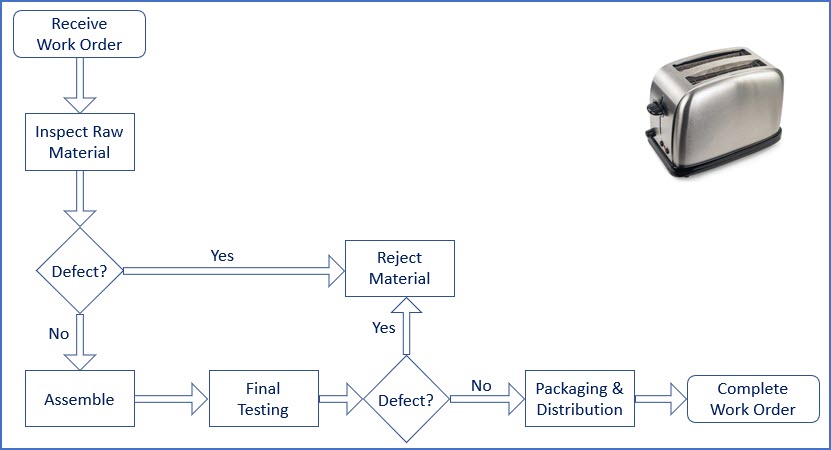
2. Check Sheet
Solving problems and making improvements requires data. Period.
The check sheet is a simple tool for collecting, organizing and analyzing data.
A Check Sheet is normally a table with defined rows and columns where the data collected is usually 1 check mark within each category. However, you can modify this concept of a data collection tool to meet a variety of different needs.
The best check sheets contain something more than data, they contain meta data.
Meta data is data about the data – like who collected the data, when (date, shift or time) the data was collected, and where (location, line, equipment number) there data collection took place.
Without this meta data, the actual data can become ambiguous and lose its integrity (think data integrity).
Let’s say we go back to our toaster example and see what a check sheet for final assembly rejects might look like. This also includes the meta data and illustrations to go along with it.
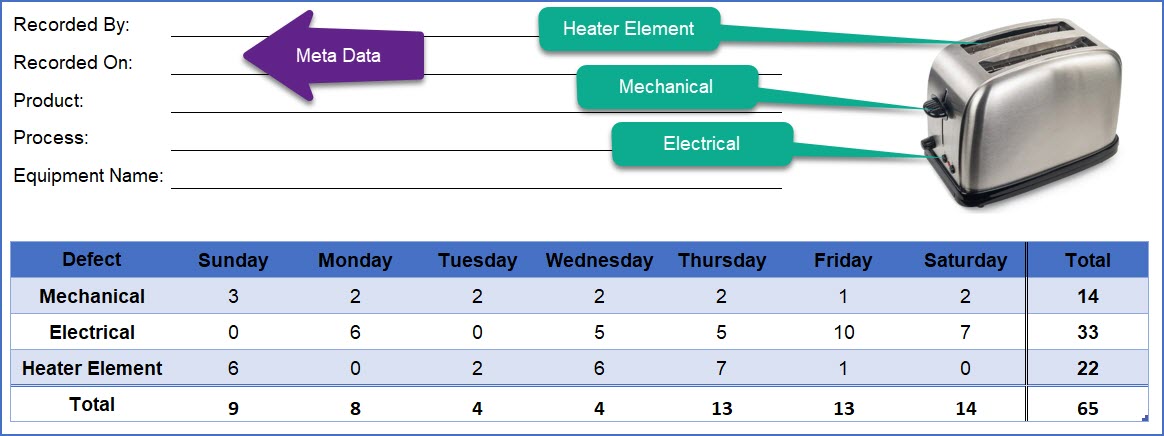
This data can then be fed into a pareto chart to identify the “critical few” defects (Hint, it’s the electrical defect).
3. Pareto Chart
The Pareto Chart is a bar chart that allows for analysis of data in search of the Pareto Principle or the 80/20 rule.
The 80/20 rule was first identified by an Italian researcher, Vilfredo Pareto, who was studying wealth and land ownership in Europe, and found that 80% of the land in Europe was owned by 20% of the population.
The 80/20 rule was popularized by Joseph Juran, who names the Pareto Chart after Vilfredo Pareto.
Juran went on to say that the Pareto Chart helps us separate the vital few from the trivial many.
Mechanically, the Pareto Chart is simply a bar chart and the categories of data are typically arranged from greatest to least on the X-axis.
The Y-axis is a count of defects, but this number can be cost, or any other variable. Pareto Charts also frequently include a cumulative frequency line to assist in the analysis.
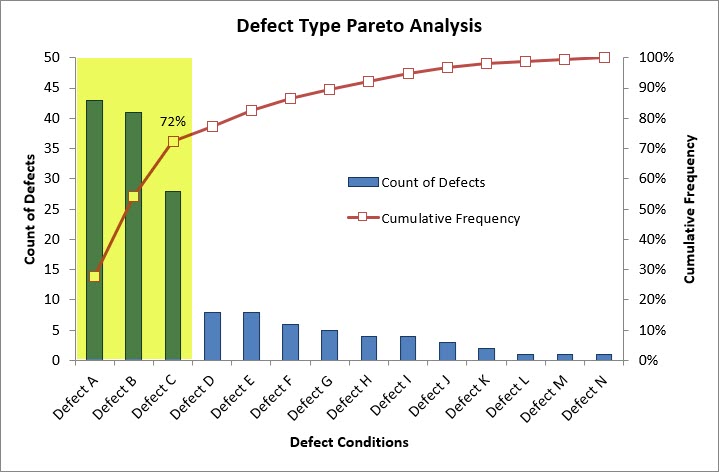
In this example, the top 3 defects (Defects A, B & C) make up only 20% (3 out of 15) of the defect conditions, however they contribute to 72% of the total number defects. If we could eliminate just these 3 defect conditions, we could eliminate 72% of the defects. That’s the Pareto Chart and the 80/20 Rule at work.
4. Cause & Effect Diagram
The Cause and Effect diagram is a visual tool to explore all the potential factors that may be causing or contributing to a particular problem.
This tool was popularized by Kaoru Ishikawa and allows you to graphically capture all the potential causes of a problem, then select those which require further investigation.
The Cause & Effect Diagram is also commonly referred to as the Fishbone Diagram, the Ishikawa Diagram, Cause & Effect Matrix, C&E Diagram or the C-E Diagram.
The Ishikawa diagram has 8 major categories (The 8Ms) that might contribute to your problem which include:
- Man
- Machine
- Method
- Materials
- Mother Nature
- Measurements
- Management
- Maintenance
Cause & Effect Example:
Let’s say you’re a Toaster Manufacturer and you received a customer complaint for a toaster that is not toasting.
We can go through the brainstorming process using the 8M’s to identify potential causes and contributing factors that require further investigation.
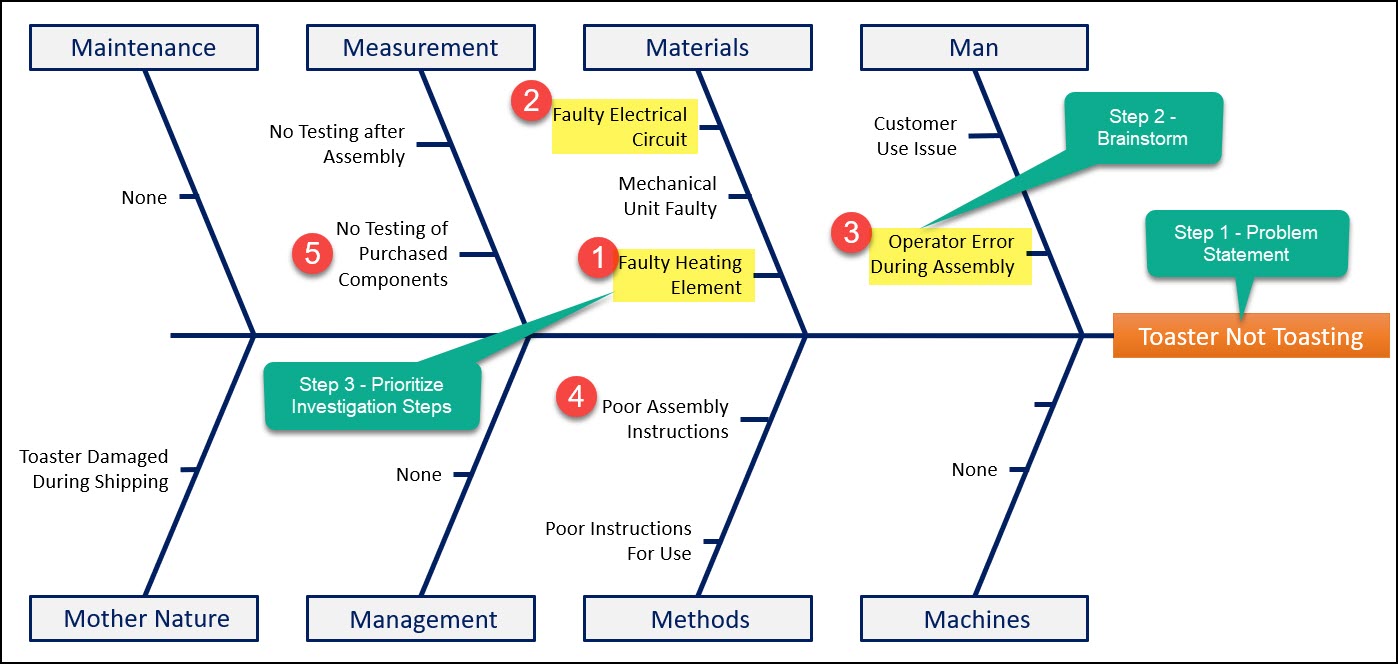
You can see here we’ve excluded maintenance, machines and Management, and identified potential causes and contributing factors in other areas.
We can also prioritize the most likely contributing factors which should give the investigation actions to conclude the root cause of the problem.
5. Control Chart
A control chart is a statistically based tool that analyzes the variation of a process.
A control chart is a time-based line graph that reflects the behavior of a process over time including normal variation and any special cause variation.
A control chart can also be described as a visual communication tool that graphs analyzed data in real-time and reflects the stability of a process.
Remember: A good process is a stable process; we want stability.
The details of the control chart, including the various kinds, how to create them, and how to analyze them can be found in the Statistical Process Control (SPC) chapter.
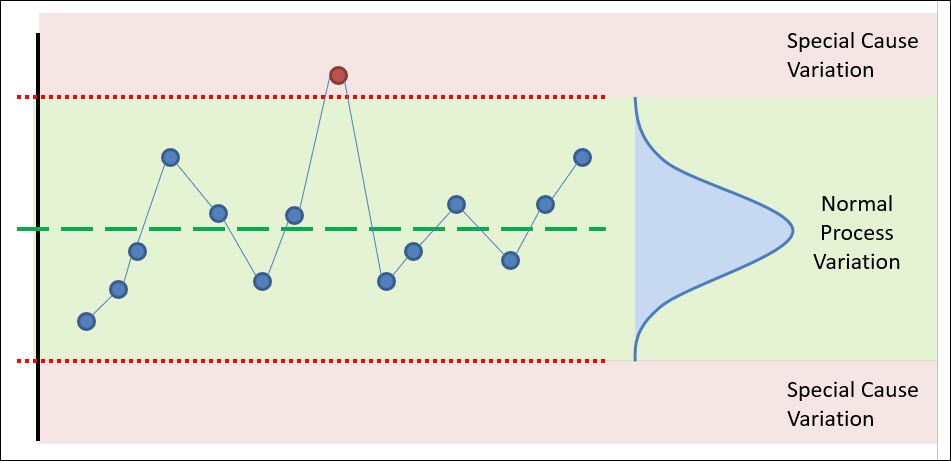
The control chart contains upper and lower control limits that are statistically based, which allow the user to identifying instances where the process appears to be behaving abnormally.
These control limits and centerline represent the “voice of the process” and are simply a reflection of the process – both the average value of your process and the natural variation of the process.
Using control charts allows you to proactively monitor your process, detect when a problem is occurring (or has occurred), which is the starting point for an improvement project.
A control chart is like a scoreboard. It can be used at the end of an improvement project to indicate if an improvement was successful or not.
6. Scatter Diagram
A Scatter diagram is a visual analysis tool that is meant to reflect the possible relationship between two variables.
The Scatter Plot visually plots pairs of data on an X-Y graph in order to reveal the relationship between the data sets.
The relationship between the two variables can be positive, negative or non-existent. The strength of the relationship can also be analyzed visually by how closely the points fall on the line of best fit.
The strength of that relationship can be expressed mathematically using the Pearson Correlation Coefficient, which is a number that ranges from a strong positive correlation (+1) to a strong negative correlation (-1).
The scatter plot is often used in the problem-solving process when we’re studying a process to understand which input variables (independent variables) are contributing to a negative outcome in a response variable (dependent variable).
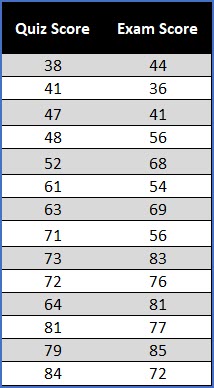 Scatter Diagram Example:
Scatter Diagram Example:
FYI – below is a hypothetical situation. I’ve created this data as an example, however I believe the conclusions are likely accurate 😊.
Let’s say that I’m studying the various factors that affect performance on the CSSGB Exam.
I propose a hypothesis that there is a relationship between quiz scores and the ultimate exam score.
So I run an experiment where I work with 14 people and have them take a quiz before the exam to determine if a relationship exists between these two variables.
Ultimately, I’d like to be able to predict their exam score based on the quiz score.
So I’ve taken these pairs of data, with the Quiz Score as the Independent Variable (X), and the Exam Score as the Dependent Variable and analyzed them using a Scatter Diagram.
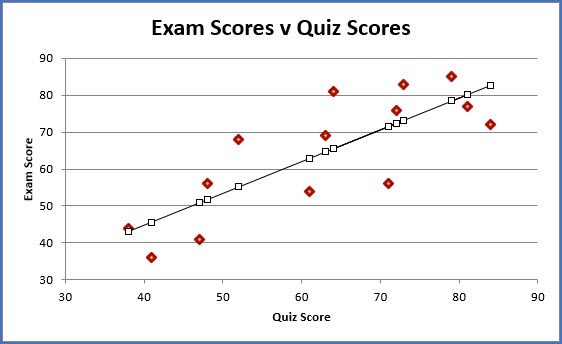
This scatter diagram indicates that a strong positive correlation exists between these two variables (r = 0.8).
If you do well on the quiz, you’re likely going to do well on the exam.
But can doing well on a quiz CAUSE you to do well on the exam. No.
This is a good opportunity to warn you about the difference between correlation and causation.
This is an example of correlation without causation.
These two variables highly correlate with each other because there are other factors like study time, study habits, or job performance that are CAUSING you to do well on both variables.
So, if you really want to do well on the exam, create healthy study habits, invest your time to study, reflect on what you’ve learned, put that into action and you will do well on the exam (and the quiz).
It’s not to say that this quiz is without value though. The quiz is an indicator of potential success on the exam.
7. Histogram
The Histogram is a tool used to visualize the distribution of continuous data.
More specifically, a Histogram is a type of Bar Chart that graphs the frequency of occurrence of continuous data and is a useful tool for displaying, summarizing and analyzing data.
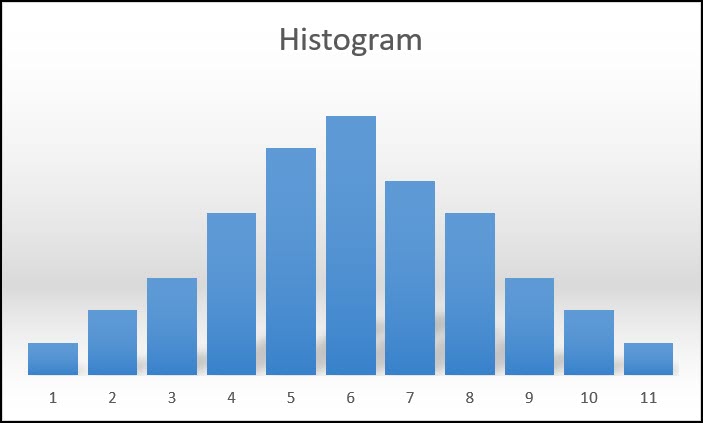
Variation is all around us. Every process or product has some level of variation.
Every data set you collect will have variation in it, and this variation will exist in a “Pattern”.
And the best way to see or understand this Pattern of variation is to graph your data using a Histogram.
There are different patterns of variation that may be revealed in a Histogram. The most common distributions, and their analysis, are discussed within the Probability Statistical Distributions (Chapter 12) of the Green Belt Master Class.
Typically, a distribution can be characterized by the central tendency of the data (Mean, Median Mode), and the “variation” (range, standard deviation, etc) within the data.
The Normal Distribution is the most common type of statistical distributions.

The histogram is a visual tool you can use as a gut check to see if your data set is approximately normal.
 Conclusion
Conclusion
As a Six Sigma Green Belt, one of the most important skills you can have, is the ability to solve a problem or improve a process.
To do this successfully, you need to be able to apply the 7 QC Tools.
These 7 tools combine a fact-based approach with a visual tool that makes solving problems easier.
Below is a quick and simple review of the definition for each of the 7 tools discussed within this chapter.
1. A Flow Chart is a visual tool that depicts the flow or sequence of a process. This can include the flow of information, tasks, people, parts, material, etc.
2. The check sheet is a simple tool for collecting, organizing and analyzing data.
3. The Pareto Chart is a bar chart that allows for analysis of data in search of the Pareto Principle or the 80/20 rule.
4. The Cause and Effect diagram is a visual tool to explore all the potential factors that may be causing or contributing to a particular problem (effect).
5. A control chart is a time-based line graph that reflects the behavior of a process over time including normal variation and any special cause variation.
6. A Scatter diagram is a visual analysis tool that is meant to reflect the possible relationship between two variables.
7. A Histogram is a type of Bar Chart that graphs the frequency of occurrence of continuous data and is a useful tool for displaying, summarizing and analyzing data.
Next: Kano Model